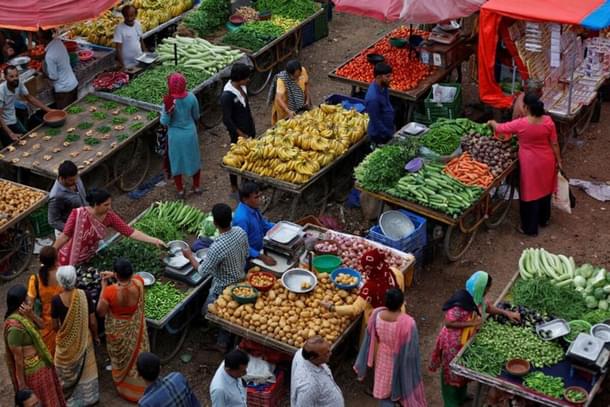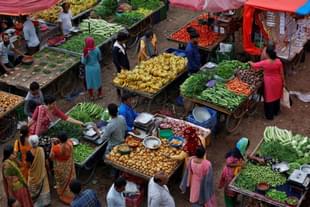Economics
Analysts See Rate Cut Delays As Inflation Hits 14-Month High, Driven by Food Costs
Arjun Brij
Nov 14, 2024, 01:01 PM | Updated 01:01 PM IST
Save & read from anywhere!
Bookmark stories for easy access on any device or the Swarajya app.


India’s retail inflation reached a 14-month high in October, driven primarily by escalating food prices, as reported by the Ministry of Statistics on Tuesday, 12 November.
The consumer price index (CPI) rose to 6.21 per cent in October, up from 5.49 per cent in September, placing inflation above the Reserve Bank of India’s (RBI) target band of 2-6 per cent.
This surge in inflation has made it unlikely for the RBI to consider a repo rate cut in December, as initially anticipated by some market analysts.
Food Inflation At The Core Of Rising CPI
The steep increase in inflation can be attributed to the rapid rise in food prices, with food and beverage inflation soaring to 10.87 per cent in October. Within this category, vegetable inflation saw a dramatic increase, reaching 42.2 per cent, up from an already high rate of 36.0 per cent in September.
This surge in prices, exacerbated by limited supply chains and seasonal factors, has intensified concerns about inflation remaining elevated above the RBI’s projections for the third quarter of the 2024-25 fiscal year.
In addition to vegetables, other essential food items experienced notable inflation, with cereals, pulses, and milk prices also contributing to the overall spike. The seasonal impact on produce, combined with weather disruptions affecting the Kharif harvest, has led to a significant strain on supply chains, further pushing up prices.
Implications For Monetary Policy And Interest Rates
The October inflation spike has placed the RBI in a challenging position, likely stalling any potential interest rate cuts until early 2025. Economists now suggest that the probability of a rate cut in December has effectively diminished.
Devang Shah, Head of Fixed Income at Axis Mutual Fund, explained that a rate-cut cycle may now only be considered starting in February 2025. “A shallow rate cut cycle of 50 basis points may start from February if inflation moderates,” Shah stated, emphasising the need for inflationary pressures to ease before a favourable policy change can be made.
The potential rate cut in 2025 now depends on inflation showing a consistent downward trend in the coming months, as well as an improvement in food supplies with the onset of the Kharif harvest.
Lowering the repo rate would theoretically reduce borrowing costs, which could stimulate economic activity by making it cheaper for businesses and consumers to access credit. However, given the current inflation trajectory, it seems prudent for the RBI to hold its rates steady to prevent further destabilising price levels.
Forecasts On Inflation And Economic Growth
Despite October’s high inflation rate, several economists remain cautiously optimistic that inflationary pressures will ease in the coming months.
Sakshi Gupta, Senior Economist at HDFC Bank, commented on the likelihood of inflation falling below 6 per cent in November. “We expect inflation to fall below 6 per cent from November as kharif crop supply improves,” Gupta said. She also projected that third-quarter inflation for the current fiscal year would average around 5.4 per cent, suggesting a gradual stabilisation.
Nikhil Gupta, Chief Economist at Motilal Oswal Group, added that the RBI might revise its inflation projections for the third and fourth quarters, considering the broader-based price pressures beyond food. He maintains an annual inflation forecast of around 4.8-4.9 per cent but noted the central bank may have to revise its stance to account for continued price pressures across multiple sectors.
On the growth front, analysts have noted that India’s GDP expansion remains relatively robust but could face minor slowdowns as the economy adjusts to inflationary pressures.
Kanika Pasricha, Chief Economic Advisor at Union Bank of India, stated that GDP growth would likely hover near 6.8 per cent, slightly moderated by inflation but still resilient. This outlook reflects the general consensus that while inflation poses a challenge, India’s economic fundamentals remain strong.
Finance Ministry On Food Inflation And Core Demand
The Finance Ministry’s latest economic review, covering data and trends through September, provides further insights into the current inflation landscape.
The report indicated that inflation expectations are softening, suggesting that public concern over rising prices may be easing. The review referenced data from both household and business surveys conducted by the RBI and the Indian Institute of Management, Ahmedabad (IIM-A), which pointed toward a stable demand environment even in the face of food price fluctuations.
The report also highlighted the government’s position that headline inflation, heavily influenced by a few essential food items, may not fully capture underlying demand. The report argued that food price volatility, while impactful, could distort a comprehensive view of demand in the economy.
The government reiterated this stance, as Chief Economic Advisor Anantha Nageswaran had previously emphasised the need to exclude food prices from India’s inflation calculation framework. Nageswaran has argued that isolating core inflation from food prices would offer a more accurate measure of the country’s demand trends and economic health.
In its 2023-24 survey report, the Finance Ministry advocated for revising India’s monetary policy framework to focus less on transient food price shocks and more on persistent inflationary factors. The Finance Ministry’s suggestion points to a broader discussion on inflation measurement, given that temporary food price surges, while significant, may not fully represent economic stability or the cost pressures facing Indian households.
Future Outlook For Inflation And Economic Policy
Looking forward, inflationary trends are likely to hinge on the performance of the agricultural sector and the potential normalisation of food prices post-kharif harvest. This period typically brings an increased supply of essential commodities, which may alleviate some price pressures. However, uncertainties surrounding weather patterns and international commodity prices could continue to influence food costs and, by extension, headline inflation.
While the likelihood of a December rate cut has diminished, analysts and government officials alike remain hopeful that inflation will trend downward in early 2025.
A sustained decrease in inflation would create a more favourable environment for the RBI to consider rate cuts, potentially in the range of 50 basis points as suggested by Shah. These cuts, if implemented, could stimulate economic activity, especially in sectors sensitive to borrowing costs.
Arjun Brij is an Editorial Associate at Swarajya. He tweets at @arjun_brij





